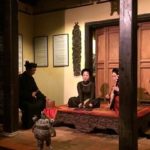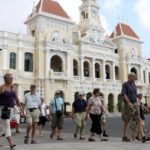Indochina dragonplum (Dracontomelon duperreanum) or Sau in Vietnamese forms Hanoi’s streets with old big trees, unique among localities in Northern Vietnam that are home to this kind of tree.
|
Phan Dinh Phung Street is famous for old big Indochina dragonplum trees, one of the most beautiful streets in Hanoi. Photo: Huy Pham/ The Hanoi Times |
Hanoi is famous for this kind of three not only for the presence on downtown streets but the dried fruit made by Hanoians.
Story of Sau trees on the street
In Hanoi, Indochina dragonplum trees line many streets such as Dinh Tien Hoang, Le Thanh Tong, Hai Ba Trung, Tran Hung Dao, Le Hong Phong, Tran Phu, among others offering cool shade. Among the streets, Phan Dinh Phung Street has two rows of these trees on the sidewalks. In addition, the trees appear on many streets citywide.
Regarding the plant’s origin, the book “Dai Nam Nhat Thong Chi” or the Geography of the Unified Great Vietnam of the Nguyen Dynasty wrote: “The districts of Phu Ninh or today’s Phu Tho Province, Bat Bat or Ba Vi District in Hanoi and My Luong or Chuong My District, Hanoi and Luong Son District of Hoa Binh Province grew a lot of Sau trees”.
In the past, people in these areas believed that what ancestors left their descendants was not money but gardens of Sau – the plant that is “beneficial to hundreds of generations.”
For that reason, every family there lived on the cultivation of the trees and sold Sau fruits. In Oriental medicine, leaves, flowers, and fruits of Sau are medicines for a number of diseases.
Moreover, their leafy canopy makes the tree looks like a giant mushroom watching from afar.
| In every April, Sau leaves fall down and cover the sidewalks of Phan Dinh Phung Street. Photo: Duy Tai |
When the French colonialists invaded Hanoi in 1883, French envoy Bonnal advocated the re-planning of the area of Hanoi under their occupation which is today Hoan Kiem District and part of Ba Dinh District.
In order to reduce the heat of summer, the local authority chose Indochina dragonplum for urban greenery. The first streets to grow these trees were those around Hoan Kiem Lake, which are today Le Phung Hieu, Le Thanh Tong, Ly Thai To, Ngo Quyen, and so on.
Tree of Hanoians’ childhood
For many generations of Hanoians, Sau trees are part of their childhood. At the beginning of May, Sau flowers bloom with a slight sour fragrance, and it is also the time when little girls pick up flowers that fall on the sidewalks, thread them onto strings to make necklaces, and pretend to be brides.
| Sau – one of favorite fruits for Hanoians and people in Northern Vietnam. Photo: Bnews |
Ingredient of Hanoi’s specialties
Today, with its special sour flavor, Sau is an important and irreplaceable ingredient of typical dishes of Hanoi such as simmered duck with Sau, sweet and sour soup with rib or pork, sour braised meat, fish or shrimp, or sour soup of morning glory – a very popular dish of every family to cool down the heat in summer.
Of them, Sau juice, home-made syrup, is good to taste with ice, an ideal drink in summer.
Meanwhile, baby Sau fruits soaked in fish sauce or boiled morning glory soup are no longer a specialty of Hanoi, but many other places nationwide. Sau is so popular that people store it for year-round usage. Notably, Sau fruits in Vietnam have been shipped abroad with dozens of tons.
Especially, dried Sau fruits become one of the typical foods of Hanoi, and a popular gift for visitors.
| Sweet and sour Sau juice is an ideal drink for summer. Photo: Hanoi culinary expert Nguyen Phuong Hai |
| Sau soft dried fruit – favorite for people in Vietnam and visitors. |
Ancient house in Ma May
NDO – Ma May, a rare quarter that still retains several old houses, has created one of the characteristics of Hanoi. Hanoi’s streets are becoming increasingly crowded and traditional features can sometimes be hidden behind modern life. But if one takes the time to relax and look around, the ancient features begin to reveal themselves.
Hanoi, HCM City see good growth of tourism revenue
NDO – In the first ten months of 2016, the revenue of Ho Chi Minh City’s tourism industry amounted to VND80 trillion while Hanoi’s reached over VND50 trillion.













